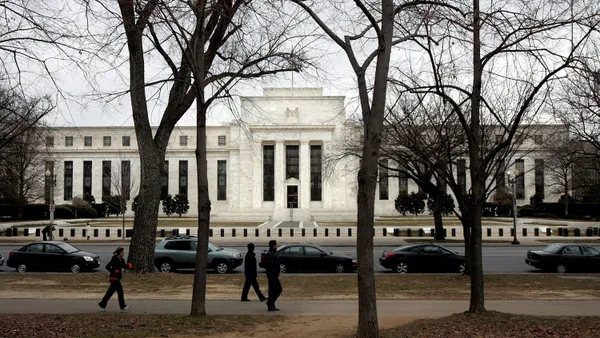Dive Brief:
- The nation’s largest banks weathered a hypothetical stress test scenario that consisted of $541 billion in projected losses, the Federal Reserve said Wednesday.
- All 23 of the banks remained above their minimum capital requirements under this year’s exam, which featured a severe downturn in real estate markets, the Fed said. The exam tested banks against a 40% decline in commercial real estate prices, a substantial increase in office vacancies and a 38% drop in housing value, the Fed said.
- The results demonstrate that large banks are well positioned to lend to households and businesses even during a severe recession, the central bank said.
Dive Insight:
Under the scenario, the aggregate common equity risk-based capital ratio held by the tested banks fell by 2.3 percentage points to a minimum of 10.1%, the Fed said.
"Today's results confirm that the banking system remains strong and resilient," said Fed Vice Chair for Supervision Michael Barr, who this year presided over his first round of yearly stress testing at the central bank. "At the same time, this stress test is only one way to measure that strength. We should remain humble about how risks can arise and continue our work to ensure that banks are resilient to a range of economic scenarios, market shocks, and other stresses."
Regional lenders held the lowest post-stress capital minimums, according to the central bank’s results.
U.S. Bank, Truist, Citizens Bank and M&T Bank had stressed capital levels between 6% and 7%, the lowest in the exam.
Charles Schwab and Credit Suisse's U.S. operations held the highest post-stress capital minimums, with 22.8% and 20.5%, respectively.
Fed officials said the test's focus on commercial real estate shows that despite heavy losses, large banks would still be able to continue lending.
The banks in this year's test hold roughly 20% of the office and downtown commercial real estate loans held by banks, the Fed said.
The projected loss rates on office properties in the scenario were roughly triple the levels reached during the 2008 financial crisis, according to the Fed.
For the first time, Fed officials included an “exploratory market shock” in this year’s exam, aimed at testing whether the trading books of the eight largest banks could withstand inflationary pressures and rising interest rates.
Fed officials said the extra shock will not affect capital requirements for the eight largest banks but will serve as a study to help the central bank decide future test scenarios and how they are conducted.
The results showed that “the largest banks' trading books were resilient to the rising rate environment tested,” the central bank said.
The Fed’s annual exercise, which was put in place after the 2008 financial crisis, aims to ensure that the country’s largest banks can withstand a severe recession. The individual results factor directly into a bank's capital requirements, dictating how much of a cushion a firm is required to hold to shield it from a severe recession.
This year’s results follow a tumultuous period in the banking sector, which has been rocked by the collapse of Silicon Valley Bank, Signature Bank and First Republic Bank.
"Some may ask how all the banks can get a regulatory thumbs-up when the industry just went through a period of turmoil,” Ian Katz, managing director of Capital Alpha Partners, said in a note, according to Reuters. “But the tests aren’t an endorsement or pass-fail grade meant for public consumption like a beauty contest.”
Consumer Bankers Association President and CEO Lindsey Johnson said the results should quell fears stemming from the recent bank failures.
“Recognizing this year's scenario was the most difficult on record, these outcomes are the best antidote to any lingering anxiety surrounding recent bank failures," she said in a statement Wednesday.













